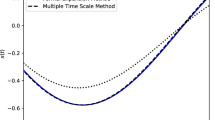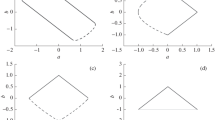Abstract
We prove an approximation result for the solutions of a singularly perturbed, nonautonomous ordinary differential equation which has interesting applications to problems in higher dimensions. Here our result is applied to a singularly perturbed, delay differential equation with state dependent time-lags (i.e., aninfinite dimensional problem). We find a new dynamical system (also in infinite dimensions), which describes, in a certain sense, the dynamics of our delay equations for very small values of the singular parameter.
Similar content being viewed by others
References
Bélair, J., and Mackey, M. C. (1989). Consumer memory and price fluctuations in commodity markets: an integrodifferential model.J. Dynamics and Diff. Eq. 1, 299–325.
Bressan, A., and Rampazzo, F. (1988). On differential systems with vector impulsive controls.Bolletino U.M.I. 2-B, (7), 641–656.
Chang, K. W., and Howes, F. A. (1984).Nonlinear Singular Perturbation Phenomena: Theory and Application, Springer-Verlag, New York.
Diener, F., and Reeb, G. (1989).Analyse Non-Standard, Hermann, Paris.
Driver, R. D. (1963a). Existence theory for a delay-differential system.Contrib. Diff. Eq. 1, 317–336.
Driver, R. D. (1963b). A two-body problem of classical electrodynamics: the one-dimensional case.Ann. Phys. 21, 122–142.
Driver, R. D. (1963c). A functional differential system arising in a two-body problem in classical electrodynamics.Int'l. Symp. Nonlin. Diff. Eq. and Nonlin. Mech., Academic Press, New York, pp. 474–484.
Fenichel, N. (1979). Geometric singular perturbation theory for ordinary differential equations.J.D.E. 31, 53–98.
Grasman, J. (1987).Asymptotic Methods for Relaxation Oscillations and Applications, Springer-Verlag, New York.
Hausdorff, F. (1927).Mengenlehre, Berlin-Leipzig.
Ikegami, G. (1989). Singular perturbations in foliations.Invent. Math. 95, (2), 215–246.
Ikegami, G. (1986). Singular perturbations for constrained systems. In Ikegami, G. (ed.),Advanced Series in Dynamical Systems, World Scientific, pp. 27–50.
Mackey, M. C. (1989). Commodity price fluctuations: price dependent delays and non-linearities as explanatory factors.J. of Econ. Theory 48, 497–509.
Mackey, M. C., and Milton, J. (1990). Feedback delays and the origin of blood cell dynamics.Comments on Theoretical Biology 1, 299–327.
Mallet-Paret, J., and Nussbaum, R. D. (1992). Boundary layer phenomena for differential delay equations with state dependent time lags, I.Arch. Rat. Mech. and Anal. 120, 99–146.
Mrówka, S. (1958). On the convergence of nets of sets.Fund. Math. 45, 237–246.
Nipp, K. (1980). An algorithmic approach to singular perturbation problems in ordinary differential equations with an application to the Belousov-Zhabotinskii reaction, Ph.D. Dissertation, E.T.H., Zurich.
Paraskevopoulos, P. D. (1993). Delay differential equations with state-dependent time lags, Ph.D. Dissertation, Brown University, Providence.
Watson, P. D. (1953). On limits of sequences of sets.Quart. J. Math., Oxford4, (2), 1–3.
Author information
Authors and Affiliations
Rights and permissions
About this article
Cite this article
Paraskevopoulos, P.D. A singular perturbation analysis with applications to delay differential equations. J Dyn Diff Equat 7, 263–285 (1995). https://doi.org/10.1007/BF02219358
Received:
Issue Date:
DOI: https://doi.org/10.1007/BF02219358




